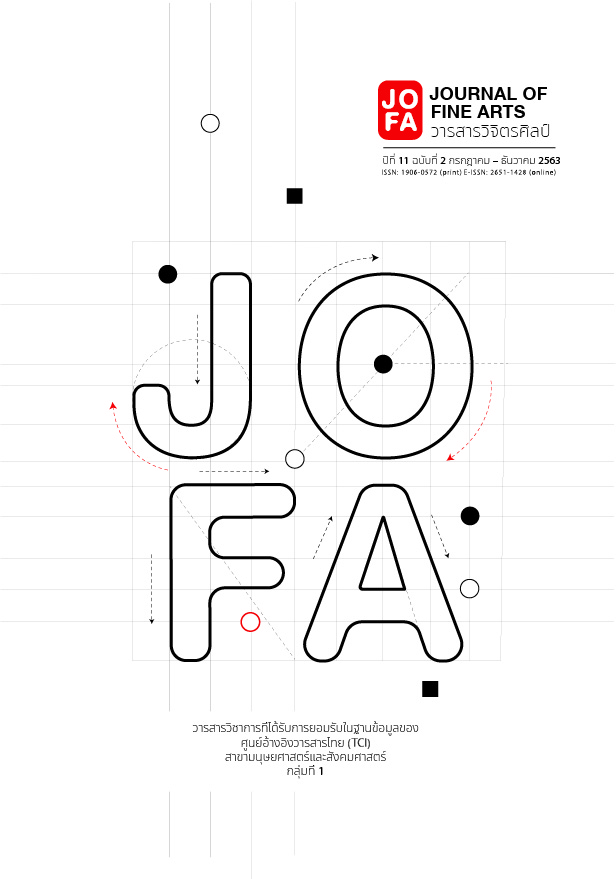ดอกเอื้องในพิธีกรรม ความเชื่อและวัฒนธรรมล้านนา
Main Article Content
บทคัดย่อ
การศึกษารวบรวมองค์ความรู้ด้านภูมิปัญญาดอกกล้วยไม้ (ดอกเอื้อง) ที่ปรากฏในพิธีกรรม ความเชื่อในวัฒนธรรมล้านนาเป็นงานวิจัยเชิงคุณภาพศึกษาเพื่อสนองพระราชดำริภายใต้โครงการอนุรักษ์พันธุกรรมพืช อันเนื่องมาจากพระราชดำริสมเด็จพระเทพรัตนราชสุดาฯ สยามบรมราชกุมารี โดยการรวบรวมองค์ความรู้เกี่ยวกับดอกกล้วยไม้ (ดอกเอื้อง) ที่ปรากฏในพิธีกรรมความเชื่อในวัฒนธรรมล้านนา ซึ่งสามารถนำองค์ความรู้ดังกล่าวไปพัฒนาในรูปแบบของมรดกทางวัฒนธรรมล้านนาในอนาคต โดยใช้วิธีการเขียนอธิบายความพรรณนาและบันทึกภาพถ่าย โดยใช้การวิจัยเชิงปฏิบัติการอย่างมีส่วนร่วม (Participatory Action Research-PAR) การลงพื้นที่ภาคสนามใน 3 จังหวัด ได้แก่ จังหวัดแม่ฮ่องสอน จังหวัดเชียงใหม่ จังหวัดลำปาง โดยเข้าไปคลุกคลีและมีปฏิสัมพันธ์กับชุมชนด้วยตนเองของนักวิจัย ซึ่งเป็นการวิจัยในลักษณะที่มุ่งสร้างความสำนึก และความตระหนักของคนในชุมชนให้มีส่วนร่วม
ผลการศึกษารวบรวมองค์ความรู้ด้านภูมิปัญญาดอกกล้วยไม้ (ดอกเอื้อง) ที่ปรากฏในพิธีกรรม ความเชื่อในวัฒนธรรมล้านนา พบว่าในวัฒนธรรมล้านนานั้น ดอกเอื้องถือเป็นดอกไม้ที่มีความสำคัญ เพราะเป็นดอกไม้ที่เบ่งบานตามฤดูกาล ซึ่งดอกเอื้องบ้างชนิดสามารถใช้เป็นตัวกำหนดการจัดพิธีกรรมในล้านนาได้อีกด้วย เช่น พิธีกรรมฟ้อนผี จะต้องอยู่ในช่วงฤดูร้อน ในช่วงที่ดอกเอื้องผึ้งกำลังเบ่งบานและก็ต้องใช้ดอกเอื้องผึ้งในพิธีกรรมนี้ด้วย หรือการทำเครื่องสักการะล้านนาในงานพิธีสำคัญ ๆ พิธีกรรมอบรมสมโภชจะนิยมทำเครื่องสักการะซึ่งหนึ่งในนั้นจะเป็นต้นผึ้ง และใช้ขี้ผึ้งปั้นเป็นดอกเอื้องผึ้ง เป็นต้น
นอกจากนี้ในแต่ละพื้นที่ที่ศึกษายังมีอัตลักษณ์ในการใช้ดอกเอื้องที่ขึ้นในภูมิภาคตามสภาพภูมิประเทศ ในแต่ละพื้นที่จะมีการใช้ดอกเอื้องแต่ละชนิดแตกต่างกันขึ้นอยู่กับประเพณี พิธีกรรม จารีต โดยมีปัจจัยเป็นตัวกำหนด คือ ฤดูกาลและสภาพภูมิประเทศนั้น ๆ เช่น อำเภอแม่แจ่มนิยมใช้เอื้องเงิน ในงานพิธีกรรมช่วงประเพณีปีใหม่เมือง อำเภอขุนยวม จังหวัดแม่ฮ่องสอนนิยมใช้เอื้องแซะ เพื่อพุทธบูชา ในพื้นที่จังหวัดลำปาง นิยมใช้ดอกเอื้องผึ้งในงานพิธีทั้งพุทธและผี ในช่วงระหว่างเดือนมีนาคมถึงเดือนพฤษภาคม ซึ่งทำให้เราเห็นว่าพิธีกรรมต่าง ๆ ในวัฒนธรรมล้านนานั้น ถ้ามองและศึกษาในเชิงลึกจะพบว่า ดอกเอื้องล้านนามีบทบาทและมีความสำคัญที่มีความเกี่ยวเนื่องกับพิธีกรรมล้านนา
ด้านงานศิลปกรรม ที่รูปแบบของดอกเอื้องเข้าไปมีบทบาทที่กำหนดรูปแบบที่ทำให้ก่อเกิดงานศิลปะและศิลปกรรมในพุทธศาสนามากมาย ทั้งในส่วนของลวดลายช่อดอกเอื้องที่ปรากฏเป็นงานเทคนิคลายคำประดับบนงานพุทธศิลป์ต่าง ๆ เช่น ธรรมาสน์ หีบธรรมเป็นต้น นอกจากนี้ในส่วนของงานหัตถกรรมที่รองรับกับนาฏยกรรมในฤดูกาลที่ไม่มีช่อดอกเอื้องก็จะมีงานดอกไม้ไหวที่ทำจากโลหะทองเหลืองตัดประกอบเป็นช่อดอกเอื้องใช้งานแทนช่อดอกเอื้องสดและลวดลายผ้าทอของชาวไทยวนในล้านนาที่มีลายผ้าทอชื่อลายเครือดอกเอื้องและลายคัวะดอกเอื้อง โดยการสร้างสรรค์ลวดลายผ้าทอที่มีรูปแบบของดอกเอื้องเป็นต้นแบบ
ในส่วนของวรรณกรรมล้านนา ปรากฏในเทศน์มหาชาติภาคพายัพ สำนวนสร้อยสังกร.เป็นการเทศน์มหาชาติฉบับล้านนาที่มีความงามทางวรรณศิลป์ในวรรณกรรมล้านนาที่กล่าวถึงดอกกล้วยไม้ในป่า เช่น กัณฑ์วรรณประเวศ กัณฑ์จุลพน และกัณฑ์มหาพน ที่พูดถึงในป่าว่ามีดอกเอื้องอะไรบ้างในระหว่างทางซึ่งนำไปสู่การตกแต่งซุ้มประตูป่า ที่เต็มไปด้วยบรรดาดอกเอื้อง ในประเพณีตั้งธรรมหลวง และการวาดภาพรูปดอกเอื้องในตุงค่าวธรรม ที่ใช้ประกอบการเทศน์ตั้งธรรมหลวงอีกด้วย
องค์ความรู้เหล่านี้ ถือได้ว่ามีความน่าสนใจมากในด้านของความหมายบ่งบอกถึงที่มาของวัฒนธรรม ความสำคัญที่เกี่ยวข้องกับความเชื่อและรูปแบบที่ก่อให้เกิดงานศิลปกรรมประยุกต์ การศึกษาครั้งนี้ได้ทำการจัดเก็บรวบรวมองค์ความรู้ด้านความเชื่อและพิธีกรรมล้านนา โดยมีดอกกล้วยไม้หรือดอกเอื้องล้านนาเป็นสัญลักษณ์ที่สื่อความหมาย ซึ่งองค์ความรู้ดังกล่าวถือเป็นส่วนสำคัญที่ทำให้เราเข้าใจสังคมและวัฒนธรรมล้านนา ที่ใช้ธรรมชาติเป็นตัวกำหนดกฎเกณฑ์ในหลายเรื่องและเป็นประโยชน์ในหลายด้าน.ทั้งทางด้านงานศิลปกรรม ประเพณีความเชื่อ พิธีกรรม นาฏศิลป์ วรรณกรรมในพุทธศาสนาด้านสังคมและวัฒนธรรม ซึ่งองค์ความรู้เหล่านี้ ถือเป็นความเชื่อที่เกิดขึ้นในสังคมล้านนา ซึ่งเป็นการเผยแพร่องค์ความรู้ เพื่อที่จะสามารถนำไปพัฒนาและปรับใช้วิถีชีวิต วัฒนธรรมในอนาคตต่อไป
Article Details
เอกสารอ้างอิง
Akchinoret, K. Læ khana Samnakngān Rāingānkānwičhai Kānchamrapatithinlæ Nangsư̄pīmaimư̄anglānnā (prakātsongkrant). [Lanna City Calendar and New Year Book Research Report (Songkran announcement)]. Bangkok: Sriprapai. 2003.
Charoensuk, S. Interview by Khruearaya, T., Ban Ko, Tambon Chang Kaoeng, Aumphoe Mae Chaem, Chiang Mai, May 16, 2018.
Chưnduang, P. Interview by Khruearaya, T., Ban Mae Suek, Amphoe Mae Sariang, Mae Hong Son, May 20, 2018.
Dumrikun, D. Lāi Kham Lānnā. [Lanna gold pattern]. Bangkok: Muang boran. 2001.
Manasæm, M. Phūsā ʻĀphō̜n Fō̜n Phī. [Clothes Costume Ghost dance]. Chiang Mai: Siwaem. 2010.
Phithakham, T. Interview by Khruearaya, T., Ban Ko, Tambon Chang Kaoeng, Aumphoe Mae Chaem, Chiang Mai, May 16, 2018.
Sipasang, W. Khrūayō̜ng Khō̜ng-ngām Mǣying Lānnā. [Lanna Woman Jewelry]. Chiang Mai: Social Research Institute CMU. 2004.
Sitthisadjathum, S. Klūaimai Pā Mư̄ang Thai (Phim khrang thī 2). [Wild orchids in Thailand
(2th ed.)]. Bangkok: Amarin. 2006.
Suranan, L. Khlōngnirāt Rayathāng Mư̄ang Nakorn Chīang Mai. [Limerick Nirat, distance Chiang Mai city]. Chiang Mai: The Center for the Promotion of Arts and Culture, Chiang Mai University. 2000.
Thananchai, I. Interview by Khruearaya,T. Ban Ko, Tambon Chang Kaoeng, Aumphoe Mae Chaem, Chiang Mai, May 16, 2018.
Wannasi, S. Interview by Khruearaya, T., Chumchon Tha Ma-O, Tambon Wiang Nuea, Amphoe Mueang, Lampang, April 15, 2018.


